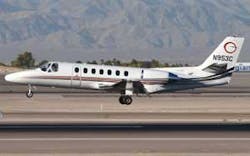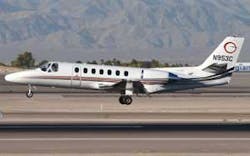Synthetic vision avionics from Cobham receive FAA approval for Cessna business jet
MINERAL WELLS, Texas–The U.S. Federal Aviation Administration in Washington granted a supplemental-type certificate (STC) for a synthetic vision system glass cockpit avionics setup from the Cobham Avionics and Surveillance segment in Mineral Wells, Texas, for use on the Cessna 550 Citation II business jet.
The installation represents the business unit’s first STC for synthetic vision in aircraft avionics on a transport-category aircraft (FAA regulations Part-25), company officials say.
Cobham developed a civil-certified synthetic vision avionics system in 2002, gaining regulatory approval for use of this kind of avionics in light airplanes and helicopters as part of the FAA Capstone program in Alaska.
“Approval of this revolutionary system for transport-category aircraft brings tremendous capability to older, analog-equipped aircraft,” says Mike Sheehan, vice president of Cobham Avionics.
The certified synthetic vision cockpit avionics for the Cessna 550 is configured with dual synthetic vision primary flight displays and dual multi-function displays, each with embedded class-A terrain awareness and warning system, integral flight management system, and digital flight recording. Additional features include dual fiber-optic attitude gyros and dual GPS-WAAS. The system uses the aircraft’s existing RVSM air data computers.
The system provides sensor comparators and cross-side sensor switching and interfaces with the original autopilot, dramatically reducing pilot workload. Additional capabilities include TCAS-I, TCAS-II, and ADS-B display, datalink weather, both single- and dual-cue flight directors, highway-in-the-sky (HITS) predictive flight director, conformal runway depiction, dual DME display, and Stormscope display.
For more information, visit Cobham Avionics and Surveillance online at www.cobhamavionics.com.
More Military & Aerospace Electronics Current Issue Articles
More Military & Aerospace Electronics Archives Issue Articles

